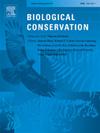Effectiveness of toxic baiting for the control of canines and felines
IF 4.9
1区 环境科学与生态学
Q1 BIODIVERSITY CONSERVATION
引用次数: 0
Abstract
Toxic baiting has been widely adopted for the control of exotic canines and felines. However, high variability in findings make it difficult to gauge the overall efficacy of this control method. We conducted a meta-analysis of the efficacy of baiting for the feral cat, red fox and dingo; our outcome of interest was apparent predator survival. Our dataset contained 121 effects from 34 studies, comprising 1402 individuals tested. When baits were distributed along tracks they increased the risk of predator death by 46 % relative to controls. However, when baits were distributed more broadly across areas the risk of predator death was comparable between baited and unbaited areas. We found no evidence that baiting was more effective at reducing canine relative to feline populations. We additionally found no evidence that Eradicat® achieved greater cat death than other baits. Higher bait densities achieved a greater risk of predator death for track baiting, but not area baiting. We found no evidence that repeat bait applications over short periods of time achieve a greater risk of predator death than single bait applications; this was consistent across both design types. Similarly, we found no evidence for an effect of bait matrix (fresh meat, dry processed bait, mixture) for either design type. Our study shows that many accepted baiting practices have little empirical support and are premature given the available sparse evidence. Further, rigorous research is of high priority in this field and will assist in clarifying the use of lethal baiting as a conservation tool.
求助全文
约1分钟内获得全文
求助全文
来源期刊

Biological Conservation
环境科学-环境科学
CiteScore
10.20
自引率
3.40%
发文量
295
审稿时长
61 days
期刊介绍:
Biological Conservation is an international leading journal in the discipline of conservation biology. The journal publishes articles spanning a diverse range of fields that contribute to the biological, sociological, and economic dimensions of conservation and natural resource management. The primary aim of Biological Conservation is the publication of high-quality papers that advance the science and practice of conservation, or which demonstrate the application of conservation principles for natural resource management and policy. Therefore it will be of interest to a broad international readership.
 求助内容:
求助内容: 应助结果提醒方式:
应助结果提醒方式:


